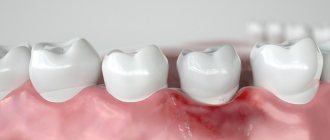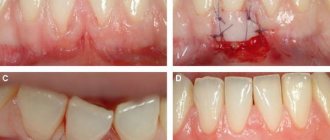23.12.2020 68738
Anyone, sooner or later, may need a tooth extraction. This occurs due to its severe destruction, progression of the inflammatory process and other reasons.
Typically, doctors use removal surgery only as a last resort, when other means are ineffective. It is important to understand that the procedure is a surgical operation that must be carried out carefully and in compliance with all safety requirements.
In this material we will touch on an important issue - the rehabilitation period. We will talk about how long it takes for the gums to heal after tooth extraction, and what rules should be followed to prevent complications from occurring. Compliance with simple safety requirements will not only significantly speed up recovery, but also ensure the safety of your health.
How much does tooth extraction hurt the gums?
Assessing how severe the harm from tooth extraction will be is not always easy. Sometimes removal can take much longer and have a very negative impact on the condition of a person’s gums. And here it doesn’t really matter which doctor performs the procedure - there are many potential complications.
Among the most notable factors of injury are the following:
- Rupture of the ligaments and muscles that hold the tooth. They help the tooth stay inside the socket and not become loose over time.
- Tissue damage. We are talking about both periodontal and periodontal tissues. They can heal for quite a long time.
- Impact on the vascular system and nerves. Serious damage to blood vessels and nerves can usually occur. It is precisely because of the likely contact of blood with pathogenic bacteria during the recovery period that it is important to observe hygiene standards.
When going through the recovery process, you should be prepared for the fact that signs characteristic of inflammation will be observed for some time. In this case, swelling may appear, the temperature of the tissue at the site of removal may increase, and bleeding may occur. Pain also becomes a frequent companion during the recovery period.
In our clinic, removal is performed as carefully and carefully as possible. The extensive experience of doctors allows us to minimize tissue damage and reduce trauma. We will also answer the question of how long it takes for gums to heal and how to properly care for the socket so that it heals as quickly as possible.
The main stages of socket healing after tooth extraction
It is impossible to clearly predict how long the hole will take to heal. The individual characteristics of the human body, the type of tooth and the characteristics of the operation are of great importance. Typically, it takes more time to restore a hole after the removal of a tooth with a large number of roots and the need for additional manipulations - creating an incision in the gum and others.
In some cases, during the removal process, crumbling and splitting may occur - then the gums will be injured even more.
Conventionally, several main stages of healing can be distinguished:
- Reduced bleeding. Depending on the characteristics of the patient’s body, the gums should stop bleeding after 2-3 hours. Some people take a little longer. If the bleeding does not stop, you should immediately consult a doctor. But this is a rare occurrence unless the patient has problems with blood clotting.
- Formation of a blood clot in the socket. It is very useful because it does not allow bacteria that cause diseases to enter the wound. You cannot remove such a clot - bleeding will open, there is a high risk of inflammation and resumption of bleeding.
- Appearance of a film on the clot. This is a white coating of the epithelium. Gradually it covers more and more space. Between the fourth and seventh day after surgery, the entire clot should turn white.
- Formation of epithelial tissue. Occurs between 20 and 24 days after surgery. The gums from the outside will be the same as next to healthy teeth - color, texture.
When the patient follows the dentist’s instructions and treats the hole carefully, there should be no complications or any problems.
How long does dental anesthesia last?
This is another important point. It is important for the patient to know that it will not hurt and to understand how long the dental anesthesia lasts. The last factor can be decisive for planning work functions for the rest of the day. Insensitivity increases the risk of injury to the tongue and mucous membranes, which is why dentists recommend refraining from eating and active speech. In the case of conduction anesthesia, problems with diction and swallowing may occur.
find out how long dental anesthesia lasts in your particular case from your attending physician. He selects 1 drug or combination and selects the dosage. The effectiveness of pain relief will depend on the sum of these criteria.
How many hours does it take for the tooth to be anesthetized depends on the drug and dosage
- Drugs with a short duration of analgesia give an effect for 30-60 minutes. For example, novocaine “works” for up to 1 hour, but in combination with adrenaline, the duration of action is extended to 90 minutes.
- The average duration of anesthesia for infiltration injection with lidocaine is 1.5-2 hours.
- Ultracaine - gives a high effect, lasts up to 5 hours, and Bupivacaine can freeze the injection area for up to 8 hours.
to predict exactly how long anesthesia will last for dental treatment for a particular patient only by taking into account all individual factors. Your doctor can guess the average exposure time, but it may vary.
Features of the gum restoration process
Sometimes patients wonder if there are any differences in the recovery process, depending on what kind of surgery was performed on the patient. The answer is yes, there are such features. Let's consider three main variants of the situation.
Standard tooth extraction
When a person is healthy, the removal went well, and the tooth itself was not classified as complex, the restoration process begins immediately.
The recovery process takes longer if the tooth was large and a wide wound appears in its place. In this case, the dentist will apply stitches. They last on fabric for 7-8 days, sometimes less or more. Throughout this time, you may feel pain or signs of an inflammatory process.
After 3-4 weeks, most patients experience complete restoration of the gums. The pain goes away, swelling is relieved, and the periodontium heals. Bone tissue begins to form, and from the outside the removal site already looks quite healthy.
Removal before prosthetics
Sometimes tooth extraction may be necessary before prosthetics can be performed. The dentist makes this decision when restoration or the use of special orthopedic structures is impossible.
The removal is done with a view to installing an implant or bridge, which the old tooth will only interfere with. A periosteum augmentation process may also be required. It is more common when teeth are removed from the upper jaw, when there is simply not enough tissue for normal implant placement.
The augmentation procedure significantly increases the recovery time. It is difficult to predict the timing here; you need the attending physician to carefully monitor your condition.
Wisdom tooth removal
The most complex and difficult to predict removal process is wisdom tooth extraction. It is necessary if the tooth grows at the wrong angle, interferes with its neighbors in the dentition, and can cause irritation and other problems.
With this type of operation, the gums can be severely damaged. There are several reasons:
- A large number of roots. They can cause significant damage to your gums during the removal process. Sometimes resection may be required.
- The wisdom tooth is often hidden behind the gum. In this case, an incision will need to be made and exposed before removal can be carried out.
- Often the tooth is located at an angle. He can strongly push against his neighbors. At the same time, the dentist decides how to reduce the pressure and not damage other teeth.
After removal, the gum is not in the best condition and may require stitches. This means that the hole will take longer to heal.
Types of pain
The nature and type of pain depends on the type and surgical intervention, the duration of the operation, and the complexity of the clinical process. Clinicians distinguish the following types:
- Aching. It is felt immediately after the anesthesia wears off. Keeps for about 2-4 days. The jaw may ache when opening the mouth or chewing.
- Intense, enduring. Occurs during extraction of a complex tooth with drainage or opening of a purulent cavity.
- Phantom. Occurs after traumatic surgery and may be felt from time to time. Phantom pain occurs with weak immunity and a low pain threshold.
It is difficult to say how intense the pain will be in each specific case, which is why it is so important to follow medical recommendations to prevent complications.
Reasons for long gum healing
Typically, the answer to the question of why gums take a long time to heal is related to the individual characteristics of the human body, as well as infection.
The addition of a secondary infection can be observed against the background of several common problems:
- The patient violated the requirements for proper gum care. Often the problem lies in the fact that too much caution has been exercised and the quality of oral hygiene has decreased.
- The wound was not properly cleaned. When patients turn to dentists with a low level of skills, there is a high probability that a tooth fragment or a piece of cotton wool will remain in the hole. This can cause serious problems and greatly increase the duration of the recovery process.
- An injury occurred. It is worth watching exactly how you handle the hole. So doctors recommend avoiding any friction, strong pressure and other mechanical irritations.
Any dentist will tell you that removal is best done when the person is completely healthy. Regeneration time may increase if there are diseases of the oral cavity, stomatitis. You should also be wary of sinusitis and sore throat - they can complicate the recovery process.
Emergency help for a festering hole
Many people are interested in the question of what can be used to treat an inflamed wound if for some reason there is no blood clot, and it is not possible to see a doctor in the near future. First, it’s worth saying that such a complication can become very dangerous, so you should never hesitate to visit a specialist. But until this moment, you can try to alleviate your condition with home methods. This can only be done with the permission of a specialist, so it is better to contact your doctor at least by phone. You also need to understand that independent attempts to relieve acute symptoms cannot replace full treatment.
Important! In many sources you can find information that it is best to treat the hole with a soda solution and hydrogen peroxide. However, most experts strongly discourage these products. Despite their antiseptic properties, soda and peroxide instantly wash out the blood clot, and the wound becomes defenseless against infection.
So, if the wound festers and bleeds, you can resort to the help of natural antiseptics. Decoctions and infusions of medicinal herbs such as chamomile and sage help relieve swelling and reduce inflammation. To prepare the product, just take a tablespoon of the dried and crushed plant, pour a glass of boiling water and let it brew for 20-30 minutes. After this, the broth should be filtered and then it can be used to gently rinse the inflamed area.
Chamomile infusion is great for rinsing
How to make regeneration faster
To make the recovery period shorter, you should treat the hole as carefully as possible. Several central means help speed up regeneration:
- Brush your teeth correctly. It is important that the oral cavity is cleaned properly and that pathogenic bacteria that can cause inflammation and other problems do not multiply in it.
- Use antiseptics. They need to be rinsed after eating. But from the side of the extracted tooth, you should not rinse your mouth too much, creating a vacuum inside the mouth.
- Try not to put pressure on the gum so that the socket is constantly at rest. Strong mechanical pressure and other similar effects on tissue are especially dangerous.
Main treatment methods
Your dentist will tell you what treatment and gum care should be like after tooth extraction. Only he can select the right drugs that are suitable specifically for your case.
Among the most common treatment methods are the following:
- Careful rinsing with preparations and tinctures with various herbal ingredients and antiseptics.
- Local application of soothing ointments and gels.
- Drug treatment. Your doctor may prescribe antibiotics, painkillers, and anti-inflammatory drugs. But we do not recommend using any medications without a prescription.
Differences in anesthesia during treatment and removal
During tooth extraction, conduction anesthesia is used, which turns off the larger nerve and lasts longer. During dental treatment, pain relief is used for deep caries, pulpitis, and periodontitis. In such cases, infiltration and intraligamentary anesthesia is more often used. Freezing after tooth treatment goes away within a few hours; it lasts longer on the lower jaw than on the upper jaw. This is due to anatomical features: the upper jaw is less dense and has a better blood supply.
Can there be complications after tooth extraction?
The issue of complications always worries patients. But if you do not have concomitant infectious diseases, and the operation is performed by an experienced doctor, the risk is very small.
There are several common likely problems:
- Hematoma at the site of removal.
- Severe swelling of the cheek.
- Numbness in the area near the extracted tooth.
- Bleeding.
In some cases, flux may also appear. Dentists should be careful when administering anesthesia. If you do not make sure that the patient does not have an allergic reaction to the drug, you may encounter a number of problems.
What to do when the hole has healed?
After the hole has healed and filled with full bone tissue, it is necessary to take care of restoring the dentition. The absence of even one tooth can lead to displacement of the remaining teeth, changes in bite, diction, aesthetic problems, and resorption (atrophy) of bone tissue at the site of the extracted tooth. A tooth can be restored using implantation, when an artificial root is implanted into the bone and a crown is installed on it. This method of prosthetics is by far the most comfortable and effective for the patient.
If bone tissue atrophy has already occurred, bone tissue augmentation is performed before installing the implant. The procedure allows you to perform high-quality prosthetics and restore the functionality and aesthetics of your teeth.
How to properly care for your gums
To prevent complications from occurring, you should follow a few simple recommendations:
- Do not heat the gum. Strong heat can stimulate the spread of the inflammatory process.
- Use a soft brush. At the same time, when brushing your teeth, try not to touch the gums at the extraction site.
- Use additional cleaning products. These include irrigators and dental floss.
- Try to use toothpastes with soothing herbal ingredients.
It is very important not to self-medicate. If any problem arises, you should consult a doctor as soon as possible.
Medicines that are most often used in the dental office
If you need to numb a tooth, the doctor may use different drugs. The list of the most popular includes:
- Novocaine. Has a short period of action.
- Lidocaine and products containing articaine. Provides a medium-duration analgesic effect.
- Bupivacaine, Hirocaine, Ropivacaine. They have a long period of action.
The doctor determines which drug to choose taking into account the complexity of the upcoming treatment procedures. It is important that the patient is not allergic to the prescribed anesthetic.










